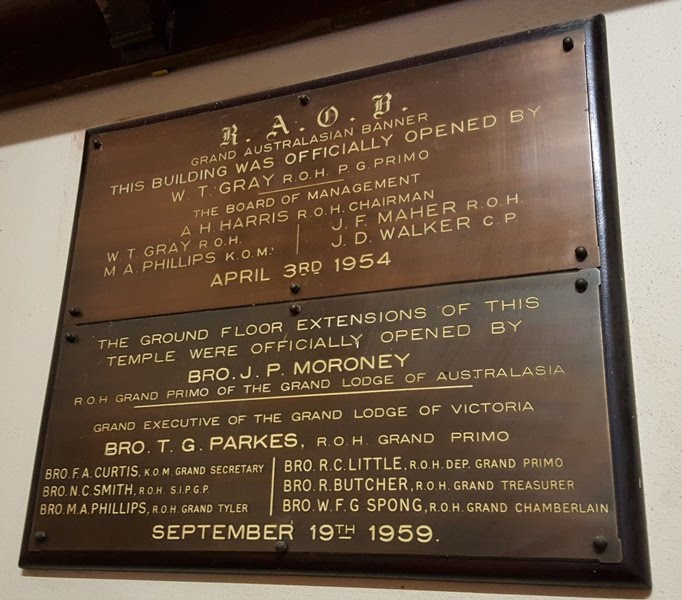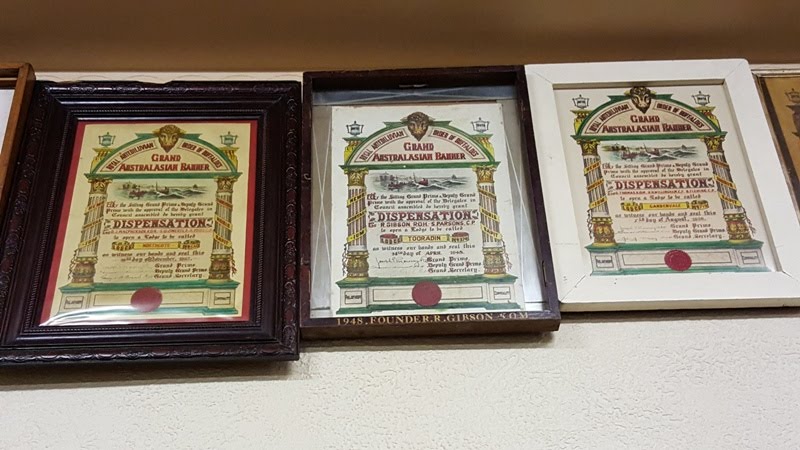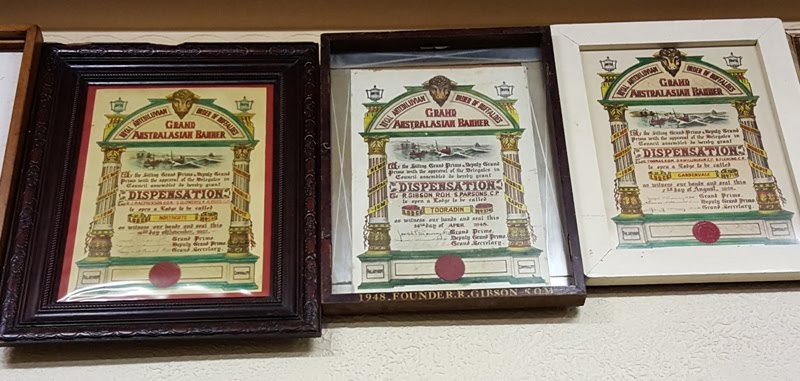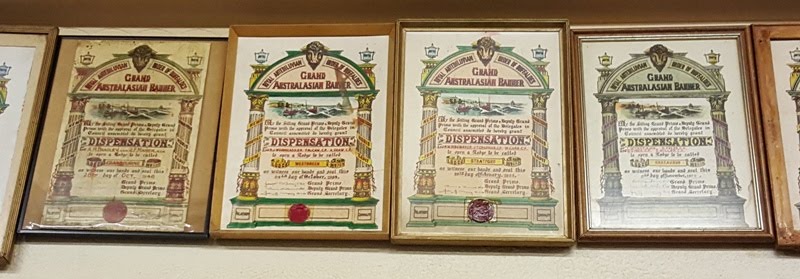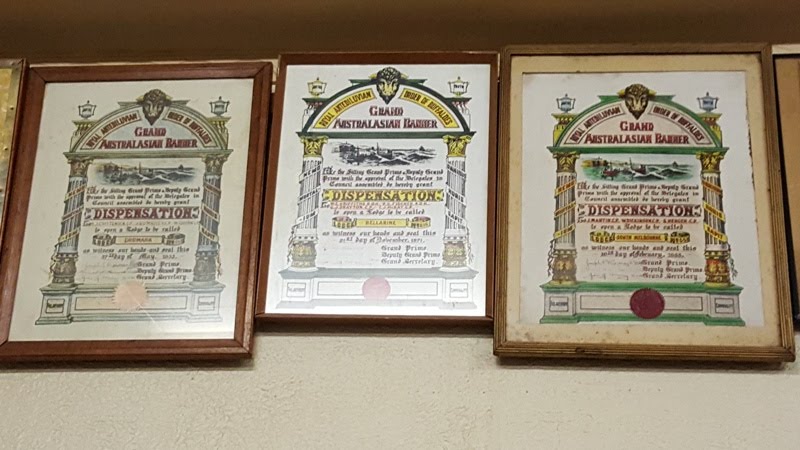On Saturday 9 April 2016, Nick C and I went to an open day at the Royal Antediluvian Order of Buffaloes (RAOB) or “The Buffs” at 22 Sutherland St, Melbourne VIC 3000. For the hipsters amongst readers, the related nightspot R.A.O.B G.A.B Buffalo Club, is accessed around the corner in the same building and has been generating publicity for the Buffs. We viewed the Ceremonial Space and not the bar, although there is a bar in the Ceremonial Space ! (Entry to the ceremonial space shown left)
The RAOB is a Fraternity with benevolent goals offering a social experience for men and originates from the United Kingdom. The Order later spread to other Commonwealth Countries, including Australia.
The three great principles of the Order are Justice, Truth & Philanthropy.
The Order's motto is Nemo Mortalium Omnibus Horis Sapit "No Man Is At All Times Wise".
Membership is open to males over the age of 18 who are willing to declare that they are "true and loyal supporters of the British Crown and Constitution". Discussion of politics and religion is prohibited at gatherings, as is gambling. In echoes of Freemasonry, the Buffs say “are not a secret order, we are an order with secrets. Our greatest secret is our “doing good by stealth”. Further, they admit men without reference to religion or race, only Communists are excluded, because a member of the Order must declare his allegiance to Constitutional authority of his country.
The 1700’s and particularly the 1800’s saw an explosion in Fraternities and “friendly societies”. Grand Lodge England (1717) was the first Masonic (F&AM or AF&AM) Grand Lodge but other fraternities like the Order of Free Gardeners (1676 making it one of the oldest), Loyal Orange Institution (LOI or LOL 1795), Oddfellows (circa 1748), Independent Order of Oddfellows (IOOF, 1819) Independent Order of Oddfellows Manchester Unity (IOOFMU 1810), Ancient Order of Foresters (AOF, 1834) Ancient Order of Hibernians (AOH, 1836) Independent Order of Foresters (IOF, 1874), and other less known groups like the Ancient Order of United Workmen (AOUW, 1868) were all formed in the fraternal heyday. The Royal Antediluvian Order of Buffaloes (RAOB, 1822) is one of these.
It was in this landscape of budding Fraternalism that the Buffs were born. The Buffaloes were founded in 1822 at the Harp Tavern, opposite Drury Lane, London England by the “eccentric” artist Joseph Lisle and comedian William Sinnett along with stage hands and theatre technicians. Drury Lane is often associated with the theatrical profession. The Buffaloes drew their name from a popular song of the time with one of it’s less serous goals being to perpetuate, ‘that hitherto neglected ballad of ‘We’ll chase the Buffalo’ “.
When the Buffaloes were founded, the French Revolution was little more than a quarter of a century old and there was Establishment resistance to emerging Unionist and Political Activists.. This was seen in Unlawful Societies Act of 1799 and later Seditious and Riotous Assembly Acts of the late 19th century. These affected the gatherings of clubs, proto-unions and societies throughout Britain, and also caught up fraternal groups like the Freemasons and the Buffs. To demonstrate the Buffaloes were not subversive the Order styled itself as the "Loyal Order of Buffaloes"'. The word "Loyal" was often mispronounced as “Royal”, and ended up being adopted into the fraternity’s name.
Despite the adoption of the word “Loyal”, the Buffaloes did not actually have royal patronage nor a Royal Charter. Any organisation using the 'Royal' prefix is required to register with the Lord Chamberlain's Office and to desist from using the title if permission was not granted. Since the Buffaloes had been using the title from the 1840s, the Lord Chamberlain agreed that no objection would be raised on continued use of the title on the grounds of long usage, provided no act by the Order arose that would disgrace its use.The addition of "Antediluvian" occurred in the 1850s. Antediluvian means: "Before the flood" referring to the time of Noah and the great flood recorded in Genesis, chapters 6-9 in the Bible. Reflecting the use of “Ancient” in the name of many Fraternities (including our own) displays a yearning for legitimacy through claims of ancient origins. Aniquity being seen as lending legitimacy to such groups (Freemason are also guilty of that practice). However it is clear the Buff’s had no such age, but in their “traditional history” (read myth) claim there were Buff “knights” who witnessed the signing of the Magna Carta (1215 A.D.)
There was a similar Order known as the City of Lushington that existed in the late 1700’s to the 1800’s which consisted almost exclusively of actors or variety artists and held its meetings, mostly for entertainment and fun, in the Inns and Taverns. In order to be a member of the Lushington’s one was required to be either an actor or artist who actually earned their living 'treading the boards'. It appears stage hands were also admitted. The meeting room was organised in the form of a City with four or more wards and so the Master or chief officer was referred to as Mayor, and the senior officers were Aldermen. Lesser officers carried the prefix 'City' in their title, for example City Taster, City Barber, City Physician. The City Taster had a most important roll in the evening’s proceedings. It was his duty before the Lodge opened to ceremoniously taste the ale on sale at the Inn. If it was found to be 'wanting' the host or landlord was 'fined' two gallons of ale which was consumed by all in attendance at the meeting without payment. This prefix of ‘City” for an officer continues in the offices of today’s Buffaloes.
The founding Buffs were all involved in one of the theatre professions, and as skilled orators, would have written their own ceremonies, often designed to impress the unenlightened with the great antiquity of the Order. I’m told there is a theatrical element to the ceremonies with puns and levity included. That said, a candidate to join the Order is told;Most unenlightened individual, you are about to become a Member of a Society, the principles of which are calculated not only to relieve the wants of the indigent and the sufferings of the distressed, but to promote Peace, Harmony and Good-fellowship throughout the World.
Sounds good !
Next to the Initiatory Degree, a second Degree (Primo) was added in 1874, a Third Degree (Knight of the Order of Merit) a little later, and a Fourth Degree (Roll of Honour “ROH”) in about 1886. Later other sub-groups were added like Knights of the Golden Horn and Companions of the Ark. Freemasons would refer to these as “appendant bodies”. These were often styled “Knights” with one, Knights Militant, wound up in 1915. The Knights of the Golden Horn, another subgroup of the Buffalo, was founded in about 1872 and seceded from the parent organization in 1925.
The Buffaloes have ceremonies and like many other fraternities of the 1800’s were heavily influenced by Freemasonry, Indeed, the Buffs are often known as ‘The Poor Man’s Freemasonry”, which is a term they are not fond of. They’ve also been called ‘Boozy Buffs,’ and don’t much care for that title either; especially as there are teetotal Lodges, and teetotal members of Lodges. Yet it is easy to see how the nickname came about, for their meeting place has traditionally been in pubs.
According to official Buffs web sites, today there are four degrees within the RAOB:
- Brother (1st degree) (Kangaroo)
- Certified Primo (2nd degree)
- Knight of the Order of Merit (Knight Sir) (3rd degree)
- Roll Of Honour (Right Honourable sir) (4th degree)
In a Minor Lodge, there are 14 Officers: Worthy Primo, City Marshall, City Secretary, City Treasurer, City Chamberlain, City Tyler, City Constable, City Registrar, City Minstrel, City Waiter, Alderman of Benevolence, Lodge Trustees x 3
Again from a current and official web site.
In some of the first meetings a new brother is seated on a chair in the middle of the room, with a bandage placed over his eyes The initiated Buffaloes are waiting outside the door; the orator being decorated with a wig for the occasion. On a given signal, they all enter the room, with what they call the Kangaroo Leap, and jump around the chair of the “degraded wretch,” (as the victim is termed) and sing the song “We’ll chase the Buffalo” This was succeeded by a solemn march, and the Buffaloes carrying brooms, shovels, mops and a large kettle by the way of a kettle drum chanted “Bloody-head and raw-bones! Bloody-head and raw-bones’ Be not perplex’d’ This is the text, Bloody-head and raw-bones! “
The charge is then given to the “victim” by the Primo Buffalo, accompanied by the most extravagant and ridiculous gestures “Degraded wretch, Miserable Ashantee! Unfortunate individual, at least you were so, a quarter of an hour since You are now entitled to divers privileges; you may masticate, denticate, chump, grind, swallow, and devour, in all turnip fields, meadows and pastures; and moreover, you have the special privilege of grazing in Hyde Park Think of that, my Buffalo You may also drink at all the lakes, flyers, canals and ponds; not forgetting the Eket and lower ditches. You are entitled to partake of all public dinners (upon your paying for the same). Such are the advantages you will enjoy but you must promise to gore and toss all enemies to Buffaloism”
To summarize there are some awful puns (such as promising to go to Hornsey Wood, and proving oneself an Hornament), followed by the removal of the blindfold, a repeat of the chorus of “Chase the Buffalo,” initiation into the signs, and some more songs. The new-made Buffalo “is then called on for the customary fees for liquor, and a small compliment for the Buffalo in waiting: the expenses are in proportion to the means or inclination of the newly-made member.” As for the reference about drinking from the Fleet, it is worth noting that in those days, the Fleet or Flete River was a notorious sewer.
During the 19th century the Order spread throughout the British Commonwealth and Lodges now exist in Britain, Northern Ireland, Canada, Australia, New Zealand, South Africa, Middle East, India, Africa, Gibraltar and Cyprus.
The order has a Rule Book, Manual of Instruction and Ceremony Lectures issued and revised by the Grand Lodge of England based at Harrogate in England. We do not know how consistent the ceremonies and customs are in different countries. In April 1866 a Grand Lodge (later known as the Grand Lodge of England) was formed to control the Order, to set laws, to establish procedures and manage administration. Divisions within the Order led to break-ups and the Grand Lodge of England fractured into smaller 'Banners' between which there was often rivalry. One Banner became the Grand Lodge of England Ltd, wrongly believing that by forming as a company they could gain exclusive usage of the name. The 'Grand Surrey Banner' proclaimed itself Mother Lodge of the World. Dozens of Banners were created around London and many more elsewhere. In Melbourne, the Buffs work under “GAB” for Grand Australasian Banner and hence the “RAOB GAB” in the name of their bar, on Dispensations (Warrants) and regalia.
Philanthropy is a great aim of the Buffs. Grand Lodge England owns and operates two convalescent homes to provide rest and recuperation facilities for members, their wives or widows recovering from illness or medical treatment.
In May 1888 the Buffalo held the first Convention of the lodges, and “Buffaloism was becoming thoroughly respectable”. Before the end of the century, work was in hand to raise funds for an orphanage. The foundation stone was laid on October 3, 1903, and the building was opened on May 30th, 1904 with the Buffs exiting that sector in 1945. In the First World War ( c. 1916) the RAOB GLE had provided Ambulances and drove them.
In Victoria, the first Buffs Lodge opened in Carlton Melbourne in 1913. According to The Age (29 March 2016), the Buffaloes are facing a membership challenge with just 300 members. In the 1950’s there were about 12,000 members in 340 Lodges. Around the same time Freemasonry in Victoria had about 120,000 members and it is clear the ROAB’s have been and are a smaller organisation than our own. The same article reports of Noel Dunstan, 84, who was present when the Buffs' city headquarters, in a warehouse between skyscrapers in Sutherland Street, off La Trobe Street, opened on April 3, 1954. It is the same building Nick and I visited. He said in those days there were meetings for different lodges there every night, and sometimes 80 people per meeting. "If you didn't get here early you wouldn't get a seat, or a beer."
The Royal Antediluvian Order of Buffaloes (RAOB) are actively seeking new members.
We wish them will in perpetuating their organisation.

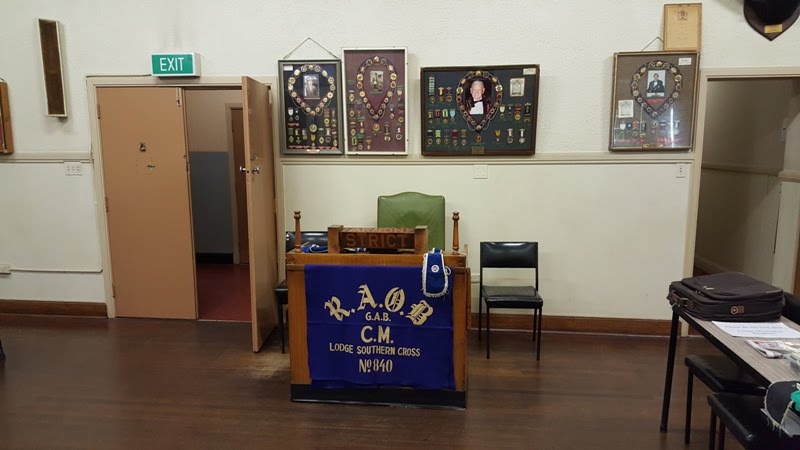


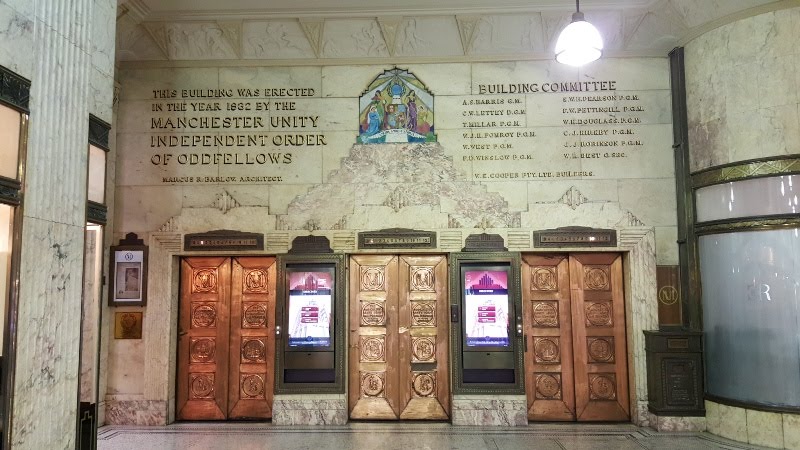

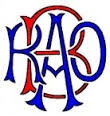

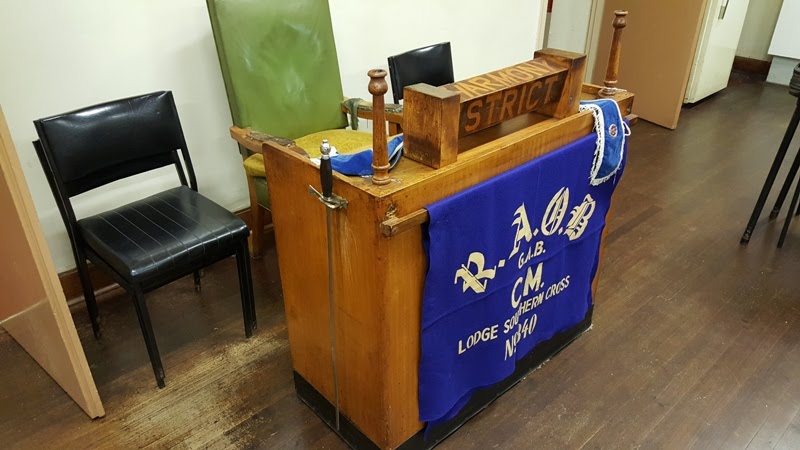
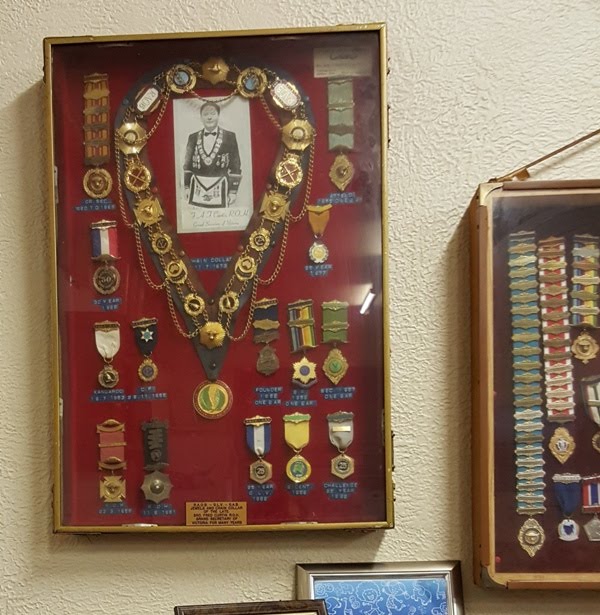
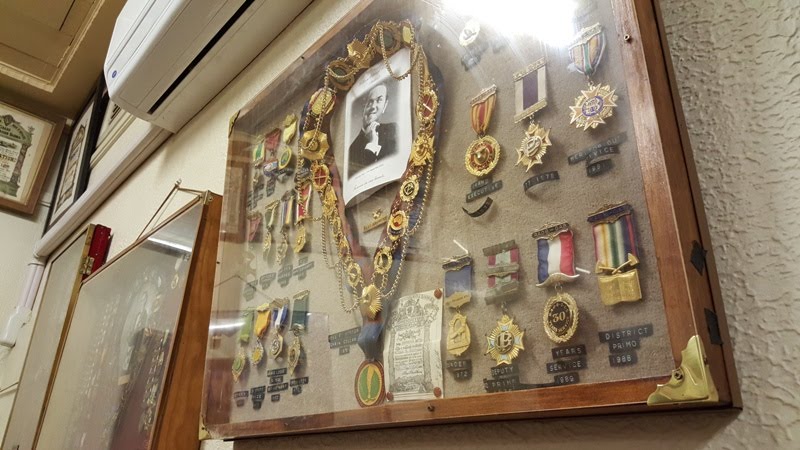
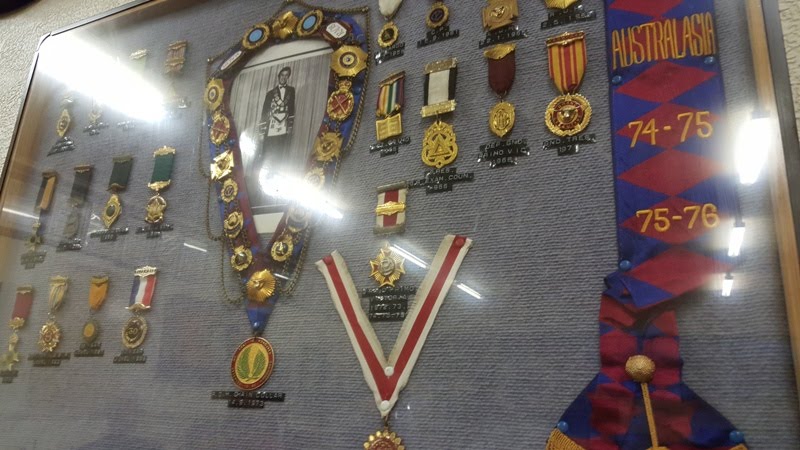
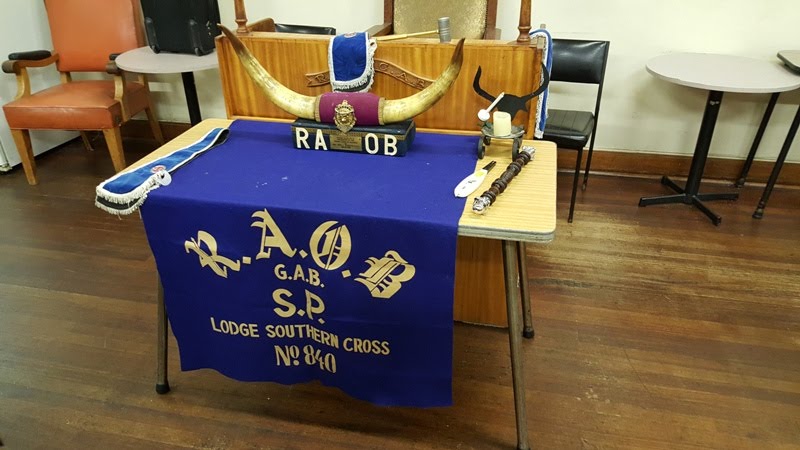
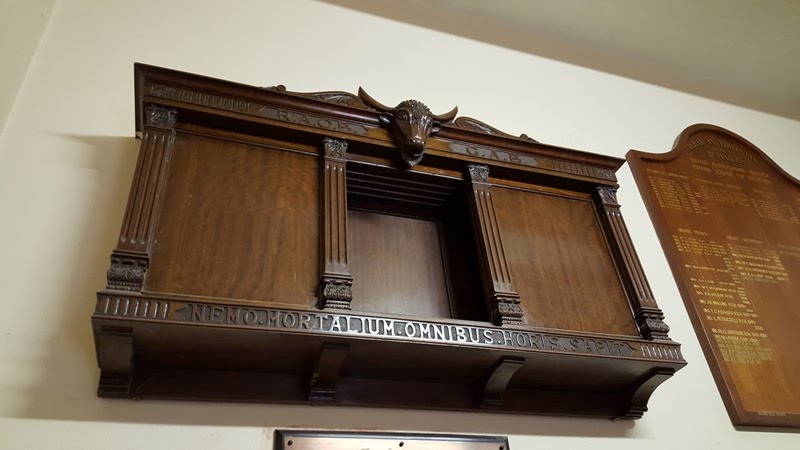
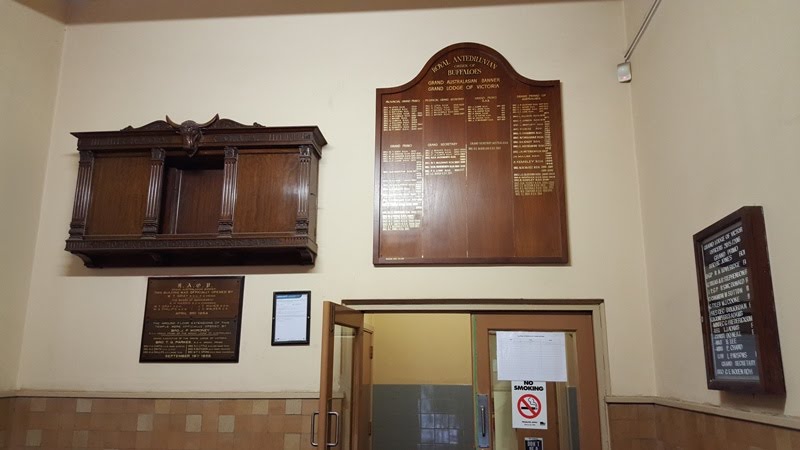

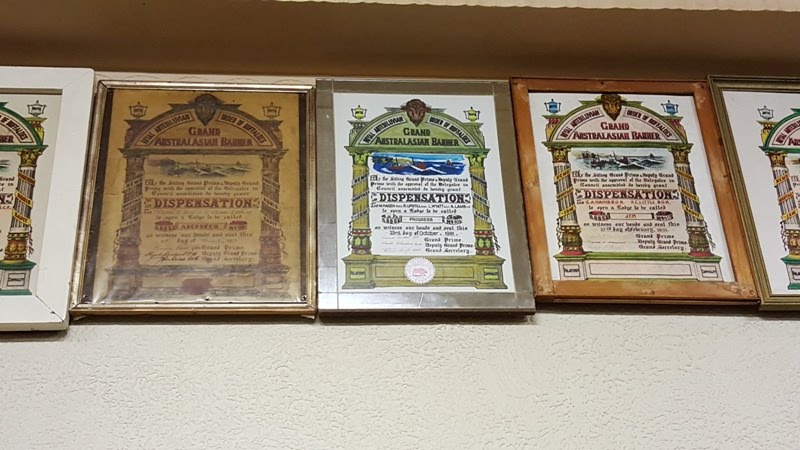

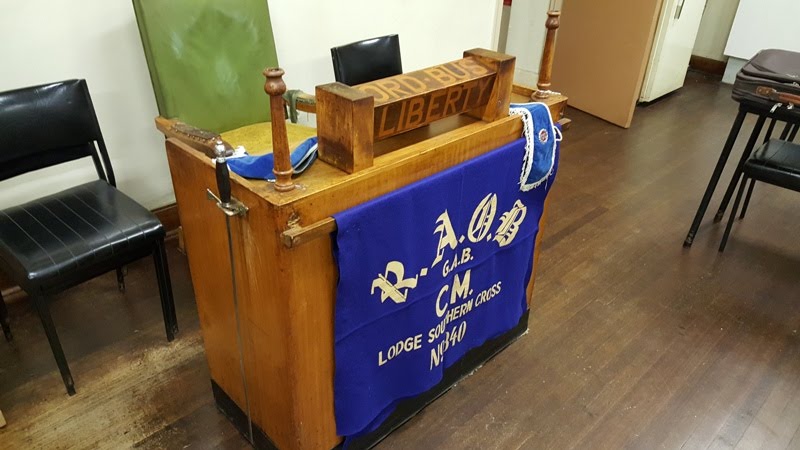

.jpg)
